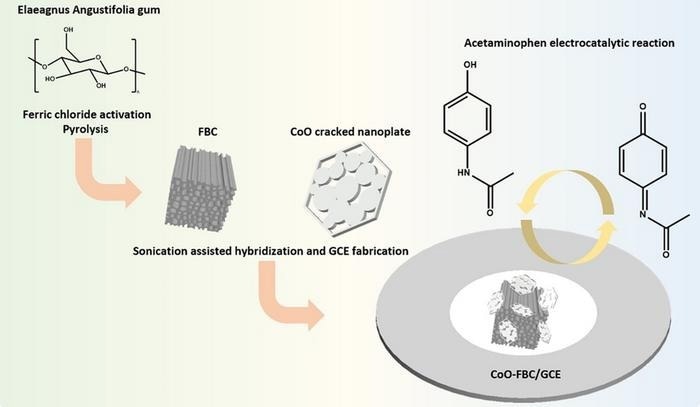A study published in Industrial Chemistry & Materials examined a new porous biomass electrocatalyst material made from Elaeagnus angustifolia gum and its electrochemical characteristics. The study also investigated the material’s specific Acetaminophen (APAP) detection capabilities.

A novel material, formed by the hybridization of biomass carbon materials activated by metal ions and cobalt oxide nanosheets, was modified on the GCE and used for the detection of APAP. Image Credit: Longyi Chen, Xinjiang Technical Institute of Physics and Chemistry, Chinese Academy of Sciences, China
APAP overuse has recently become a serious health risk and societal burden. Rapid and automated electrochemical detection is one essential technique for determining the amount of APAP in human urine.
APAP is a popular analgesic and antipyretic drug. Misuse causes an excess of APAP in bodily fluids, which can result in serious side effects such as acute liver injury and liver failure. Detecting APAP in the human body is expensive and complex.
Several processes, including high-temperature calcination, use natural Elaeagnus angustifolia gum as the base material. Ferric chloride is then used to activate this material, creating a porous natural carbon-based substance with a 2.6-fold higher specific surface area than BC.
Cobalt oxide doping was selected based on relevant research to improve conductivity, allowing for the specific recognition of APAP molecules in urine during sensitive and selective acetaminophen detection testing.
Compared to FBC/GCE, the Ipa of FBC-CoO/GCE modified with cobalt oxide is almost double. It provides automation, miniaturization, increased sensitivity, and faster speed than conventional liquid chromatography detection techniques.
This study used natural resources, such as gum from Elaeagnus angustifolia, to create FBC using simple preparation procedures. The team created APAP sensors with exceptional sensitivity by altering the hollowness of cobalt oxide cracked nanosheets through modification during the preparation process. This study's uric acid and APAP reaction peaks can be successfully separated and identified within a reasonable physiological concentration range.
Additional improvements can improve the performance of CoO-FBC/GCE, paving the way for in-depth research in future projects.
These enhancements include investigating the biomass activation process, tailoring the morphology and size of cobalt oxide cracked nanosheets, analyzing the ultrasonic steps and the ratio of biomass carbon to cobalt oxide, enhancing the alkaline co-precipitation method, and co-doping with other transition elements to produce high-performance sensors.
The research team includes Yihan Zhang, Zehong Gao, Xamxikamar Mamat, and Longyi Chen from the Chinese Academy of Sciences Xinjiang Technical Institute of Physics and Chemistry, as well as Yiliyasi Baikeli from Dezhou University’s College of Chemistry and Chemical Engineering.
The Biological Resources Programme, Chinese Academy of Sciences (KFJ-BRP-007-011) funded the study. The authors also acknowledge the Tianchi Talent Program of the Xinjiang Uygur Autonomous Region.
Journal Reference:
Zhang, Y. et. al. (2024) Improved voltammetric discrimination of acetaminophen and uric acid in urine using CoO biochar nanocomposite. Industrial Chemistry & Materials. doi.org/10.1039/D4IM00069B